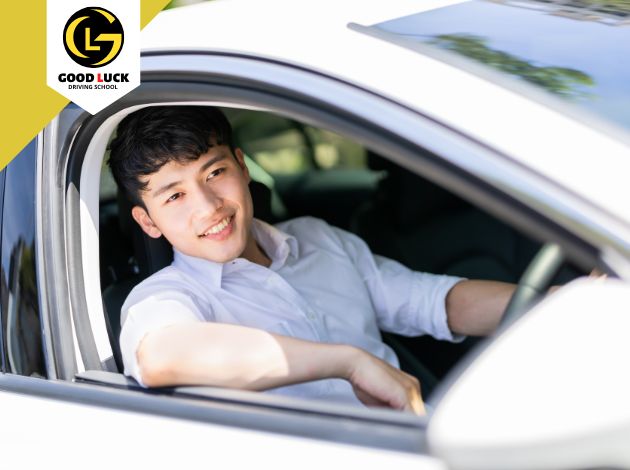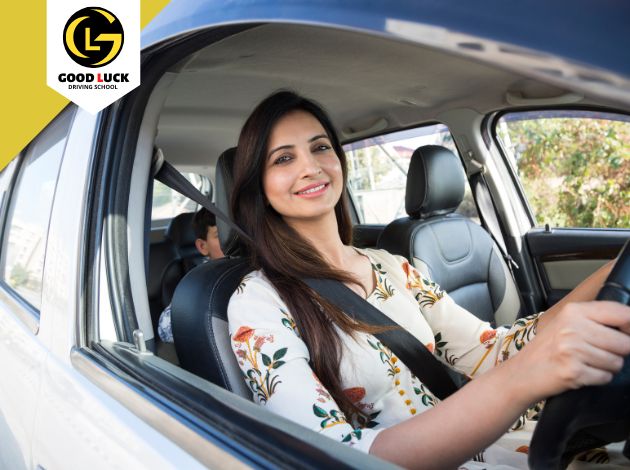Course Structure
Good Luck Driving Schools shall guide you every step of the way through to finally taking your driving test.
When figuring out how to drive there are an assortment of driving methods, moves and rules you should rehearse altogether to dominate the craftsmanship and at last persuade your driving educator and test inspector that you are protected out and about.

Knowledge of your vehicles basic workings and mechanics through to how to check the oil, water levels, tyre pressure and tread depth and how to check that your brake, headlights, indicators and reversing lights are all working correctly
What to do when getting into you vehicle. ensuring the seat and mirrors are positioned correctly, checking dashboard warning lights etc before getting ready to move off
How to put the car into gear, signalling and what blind spots to check before you disengage the handbrake, the clutch and start to accelerate an move out of you parking space
How to safely use the clutch and changing up and down through the gears to control your speed
In a controlled and safe manner
How to position the car when arriving at junctions, traffic lights Pedestrian crossings or hazards
In a controlled and safe manner
From junctions, once again blind spot and mirror checks and preparing to turn into a road safely
Teaching you how to parallel and reverse park into spaces or car parking bays
We teach you and then practice how to safely join emerging junctions and cross roads
We teach you how to approach a roundabout how to enter a roundabout and the correct signalling procedure when going round a roundabout.
Maintaining speed overtaking and accelerating a decelerating
What is a hazard how to react to hazards and prepare before a potential hazard is realised.
How to perform an emergency stop safely.
How to drive safely in rain snow and icy conditions
COMPETENCIES YOU WILL NEED TO LEARN
Your driving test will cover many of the following areas if you have knowledge and experience in these areas you will pass your driving test.
- The Highway Code
- Know Your Traffic Signs
- Vehicle Handbook
- Other Traffics
- Signals
- DSSSM
- Driving Position
- Head Restraints
- Seat Belts
- Doors
- Gears And Handbrake Safety Check
- Mirrors
- Order Of Adjustment
- Mirror Adjustment, Including Anti-Dazzle
- Variety Of Seat Adjustments
- POWER (Petrol - Oil - Water - Electrics - Rubber)
- Daily And Weekly Vehicle Checks
- Head Restraints
- Service Intervals
- Doors
- Gears And Handbrake Safety Check
- Planning For Journeys
- Clear Windscreens
- MSM And PSL
- Observation And Blind Spots
- Control And Co-Ordination
- On Level And On Gradient
- At Angle And Straight Ahead
- Co-Ordination Of Accelerator, Clutch And Footbrake
- Handbrake And Steering
- Where, When And What To Look For
- Suitable Stopping Places
- Signals When Necessary
- Normal Driving
- Lane Discipline
- Passing Stationary Vehicles And Obstructions
- Bends
- MSM And PSL
- Other Vehicle’s Positioning (LGV, Cyclists Etc)
- Handbrake And Steering
- Wide And Narrow Roads
- One-Way Streets
- Interior And Exterior
- Flat, Concave And Convex
- MSM And PSL
- When To Use Them
- Why They Should Be Used
- How To Act On What Is Seen
- Blind Spots
- Frequency Of Checks And Why
- Risk Awareness In Connection With: Drivers, Cyclists, Motorcyclists, Pedestrians, Animals, Road Works, Emergency Vehicles And Any Other Road Users
- MSM And PSL
- Hazard Perception
- Visual Warnings
- Times And Places Of High Risk
- Weather Conditions
- Scanning And Priorities
- Appropriate Speed
- Making Progress
- Hesitancy
- National Speed Limits
- Restricted Speed Limits
- Road And Weather Conditions
- Traffic Conditions
- Pedestrian Activity
- Stopping Distances
- Meeting, Crossing And Overtaking
- One Way And Two Way Roads
- Three-Lane Two-Way Roads
- Major, Minor And Narrow Roads
- Dual Carriageways
- MSM And PSL
- When And Why To Give Way
- Passing Places And Warning Signs
- Obstructions, Parked Vehicles
- Planning And Anticipation
- How To Act On What Is Seen
- Motorways
- T-Junctions And Y-Junctions
- Crossroads And Slip Roads
- Marked And Unmarked Junctions
- One-Way Streets
- Urban, Rural And Dual Carriageways
- MSM And PSL
- Turning, Entering And Emerging
- Advance Warning Signs And Road Markings
- Zones Of Vision
- Priorities
- Mini And Major
- Multiple And Satellite
- Traffic Light Controlled
- Approaching And Entering
- Leaving And Turning
- Straight Ahead
- MSM And PSL
- Lane Discipline
- Correct Position
- Zones Of Vision
- Observation
- Priorities
- By Arm And By Indicators
- Brake, Reversing And Hazard Lights
- By Other Road Users And Traffic Controllers
- Why Signals Are Necessary
- When And How To Signal
- Unnecessary Signals
Book your first driving lesson for only £35/hour (min 2 hr)
Book a lessonFAQ
We are based in Morden and provide driving lessons in Merton, Wimbledon, Sutton, and nearby areas.
We offer lessons in English, German, Urdu, Hindi, and Punjabi.
Yes, all our instructors are DVSA-registered, experienced, and committed to helping you pass your driving test.
Yes, we offer intensive courses designed to get you test-ready in the shortest time possible.
Each lesson includes a fully maintained, dual-controlled car, pick-up from a location that suits you, and expert guidance from a dedicated instructor.
You can choose between 1.5-hour or 2-hour lessons, depending on your schedule and preference.
Yes, we offer refresher lessons for those who need to regain confidence or sharpen their driving skills.
Yes, we offer support for both the theory and practical tests, including mock exams to help you prepare.
No, there are no additional charges for evening or weekend lessons.
You can easily book a lesson by contacting us through our website or by phone 0784-800-6910.
We cover Merton, Sutton, Wimbledon, Croydon, Kingston, and South West London. If you don’t see your area listed, contact us to check availability.
Yes, we offer flexible pickup locations, including your home, workplace, or college.
Yes, we have instructors available for both manual and automatic driving lessons.
Yes, we offer lessons throughout the week, including evenings and weekends, at no extra cost.
We may still be able to help. Contact us, and we’ll check if an instructor is available near you.
These are basic safety and maintenance questions about your car. You’ll answer one ‘Tell Me’ question before driving and one ‘Show Me’ question while driving. Our instructors will help you practice them.
If you cannot read a number plate from 20 metres away, the test will not continue, and you will have to rebook. Always bring your glasses or contact lenses if needed.
Yes, you can take your test in the same car you’ve been learning in. This helps you feel more comfortable and increases your chances of passing.
CALL US AT






